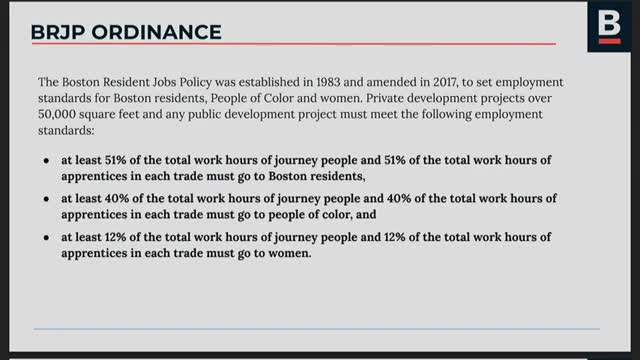Boston city officials unveil compliance dashboard for BRJP ordinance monitoring
April 18, 2025 | Boston City, Suffolk County, Massachusetts
Thanks to Scribe from Workplace AI , all articles about Massachusetts are free for you to enjoy throughout 2025!

This article was created by AI using a video recording of the meeting. It summarizes the key points discussed, but for full details and context, please refer to the video of the full meeting. Link to Full Meeting
The BRJP mandates that a minimum percentage of construction jobs be allocated to Boston residents, with specific targets for women and people of color. Currently, compliance rates remain low, with only 21% of construction hours worked by Boston residents in 2024, a figure unchanged from the previous year. This lack of compliance translates to an estimated loss of 3 million hours of work, equating to approximately $174 million in potential earnings for local workers.
City officials emphasized the importance of monitoring compliance through seven administrative requirements, which include attending pre-construction meetings and providing documentation of employee demographics. Violations can result in penalties of up to $300 per day and can affect future project awards.
The newly developed dashboard will allow both city staff and contractors to track compliance metrics by project and contractor, making it easier to identify areas needing improvement. As of mid-April, the dashboard indicated that only 40% of workers on city projects were people of color, 6.7% were women, and 23.5% were Boston residents.
Michael Endale from the Boston Planning Department presented an analysis showing that achieving the BRJP targets could significantly boost the local economy. If compliance were improved to meet the 51% target for resident participation, it could add $110 million to the city’s gross product and create hundreds of new jobs.
The meeting underscored the city’s commitment to ensuring that economic growth benefits all residents, with officials expressing optimism that closing the compliance gap could lead to higher incomes and a stronger local economy. The next steps involve ongoing monitoring and engagement with contractors to ensure adherence to the BRJP, ultimately aiming for a more equitable workforce in Boston's construction industry.
Converted from Labor, Workforce & Economic Development on April 18, 2025 meeting on April 18, 2025
Link to Full Meeting
Comments
View full meeting
This article is based on a recent meeting—watch the full video and explore the complete transcript for deeper insights into the discussion.
View full meeting
